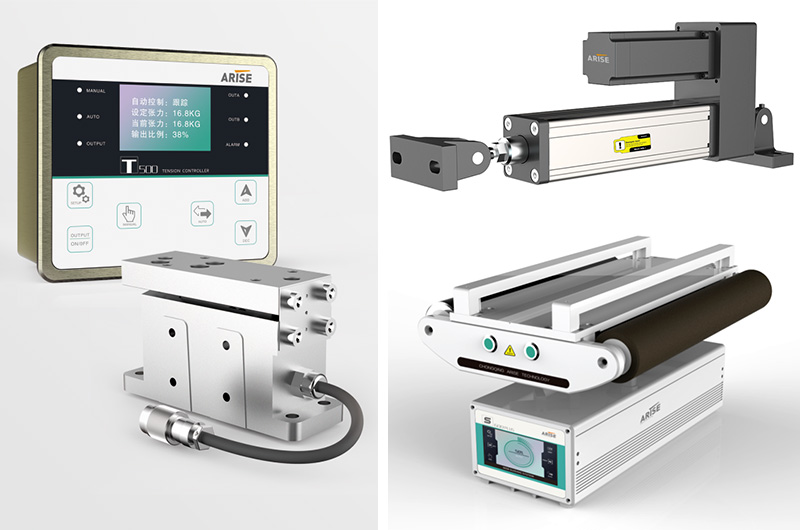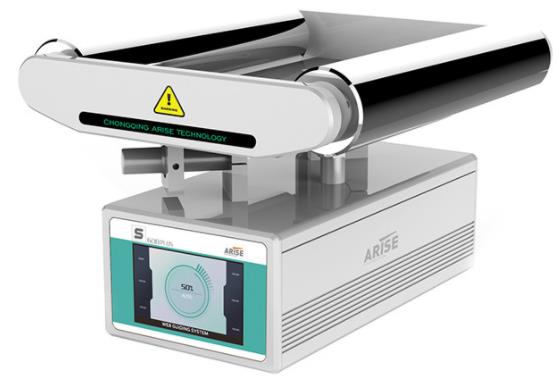What Are The Main Components Making A Web Guiding System Working Effievtively
A web guiding system is made up of several key components, including a web guide sensor, a web guide controller, a web guide actuator, a human-machine interface, a power supply, a mechanical structure, communication interfaces, diagnostic and monitoring tools, and safety precautions.

Web Tension Control Devices Of Web Guiding System
Because it ensures correct tension in the moving web throughout manufacturing operations, web tension control is an important aspect of a web guiding system.
Load cells
Load cells are sensors that measure and quantify the force exerted to the web by the roller or other guiding devices. They convert tension force into an electrical signal that is used by the controller to control tension.
Brakes
Brakes are mechanical or electromagnetic devices that apply controlled resistance to the web, hence controlling tension. Magnetic powder brakes can be applied directly to the web or through a tension control mechanism like a dancer roller or a pneumatic brake.
Clutches
Clutches are mechanical devices that generate torque in order to manage web tension. By engaging and disengaging the web from the motor system, they allow for precise tension control.
Dancer rollers
Free-rotating rollers used to gather or release web tension are known as dancer rollers. They move up and down in reaction to web tension and give feedback to the controller, which modifies the tension.
Pneumatic or hydraulic cylinders
Pneumatic or hydraulic cylinders can be used to apply or release strain on the web by adjusting the position of the guiding devices or rollers. By manipulating them, the controller manages the tension in the web.
Inverters or drives
Inverters or drives regulate the speed of the motors that power the web guiding system. The tension in the web can be changed by modifying the motor speed.
Algorithms And Controllers For A Web Guidance System
PID controllers (Proportional-Integral-Derivative)
The web PID controller is commonly used to adjust web tension and position in web guiding systems. They compute the difference in web position or tension between the desired position or tension and the actual position or tension measured by the sensors. The controller then changes the guiding devices or rollers by providing control signals that provide proportional, integral, and derivative actions to rectify the error and maintain accurate web alignment.

PLC (Programmable Logic Controller)
Web guide controllers that take sensor inputs, execute control logic, and generate control signals for guiding devices or rollers are known as PLCs. PLCs are programmable and can be configured to perform a variety of control techniques, such as PID control, feed-forward control, and advanced control algorithms, based on the requirements of the production process.
Feed-forward control
The mechanism of feed-forward control prevents web misalignment by predicting changes in web tension or position based on known process factors. Feed-forward control algorithms predict web behavior using mathematical models or empirical data and provide appropriate control signals, improving system responsiveness and accuracy.
Adaptive control
Adaptive control is a control strategy that adapts control settings in response to changing process conditions in order to maintain optimal performance. Adaptive control algorithms update the control settings on a continual basis based on real-time sensor data, responding to changes in web properties, machine speed, and other process variables, ensuring perfect web directing even under changing conditions.
Fuzzy logic control
Fuzzy logic control is a type of control system that uses fuzzy logic to process sensor inputs and generate control signals. Fuzzy logic provides a mathematical foundation for dealing with uncertainty. Fuzzy logic controllers can deal with ambiguous or imprecise inputs and are useful in web guide systems where process variables are not well-defined or change over time.
Neural network control
Neural network control is a control method that uses artificial neural networks to process sensor inputs and generate control signals. Neural networks have the ability to learn from previous data and adapt to changing process conditions, making them ideal for sophisticated nonlinear and dynamic web guiding systems.

User Interface And Operator Controls Of Web Guiding System
The user interface and operator controls of a web guiding system are designed to make it easy for operators to interact with the system and monitor its performance.
HMI (Human-Machine Interface)
The HMI is the graphical interface that allows operators to communicate with the web guidance system. It typically incorporates a touchscreen display that provides visual feedback on the condition of the system, such as web position, tension, and alarms. The HMI may also allow operators to alter control parameters and configure system settings, as well as set desired web position or tension.
Control panel
The control panel is a physical interface that allows users to control the web guidance system through the use of buttons, switches, and knobs. It may provide options for adjusting the guiding devices or rollers, setting tension limits, starting system calibration, and conducting other manual control tasks.
Remote control
Some web guiding systems may additionally provide remote control, allowing operators to interact with the system via remote control devices or a remote access interface. Remote control makes it easier and more flexible to run the system from various locations inside the manufacturing environment.
Alarms and notifications
The user interface may incorporate alarms and notifications to alert operators to any flaws or abnormalities in the web guiding system, such as web misalignment, tension variances, or system malfunctions. Alarms and notifications can help operators identify and address problems quickly, allowing the system to run smoothly and effectively.
Data visualization and logging
The user interface may display visual representations of real-time and historical data, such as web location, tension, and other process factors. Data visualization can help system administrators monitor system performance, spot patterns, and make informed decisions. Data logging is another option that allows operators to examine historical data for troubleshooting, analysis, and process optimization.
System status and diagnostics
The user interface may display information about the system's health, communication status, and diagnostics. Indicators, status messages, and diagnostic tools can all be used to convey information to operators about the performance and health of the system.
Help and documentation
The user interface may also incorporate aid and documentation tools such as user manuals, online help, and troubleshooting guides to assist operators in effectively operating and maintaining the web guidance system.
Summary
The web guiding system's components work together to accurately align and steer online material during production operations, ensuring high-quality output and efficient operation.
- Art
- Causes
- Crafts
- Dance
- Drinks
- Film
- Fitness
- Food
- Spellen
- Gardening
- Health
- Home
- Literature
- Music
- Networking
- Other
- Party
- Religion
- Shopping
- Sports
- Theater
- Wellness


